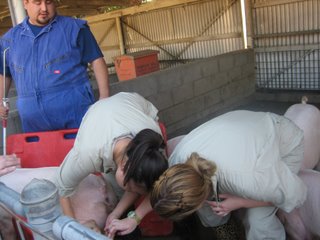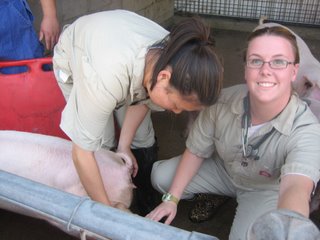Veterinary Issues
. I just recieved my first veterinary issues reflection back (I got and A :-) ) and I thought that some people might be interested in learning about some of the topics that we discuss in class, so I am posting a copy of my paper:
Today Elisabeth Sliva, Assistant District Attorney and Jackie Cruz, Deputy Sheriff, San Diego County shared their experience of the avian quarantine due to an outbreak of Exotic Newcastle Disease (END) and how it led to the Woodchipping Chickens Case. As preparation to their presentation I read several articles about the END outbreak and the woodchipping incident.
The two major questions that arose to me after during class were:
1. Is the current method of slaughter of poultry for consumption humane?
2. What is going to be done differently the next time a disease that has the potential to affect meat for consumption such as the Avian Flu comes to California?
After reading the many one sided media stories regarding the woodchipping of chickens prior to attending the presentation in class I totally understand the publics outrage that the AVMA would stand beside Dr. Cutler’s opinion that woodchipping chickens was an effective method to dispose of a large number of chickens quickly. One of my classmates posed the question, “what would have happened to all of the woodchipped chickens if they had gone to slaughter if their was no quarantine in place?” I was shocked at the presenters reply. The method of slaughter that they described taking place at the slaughtering house seemed less humane to me then the woodchipper, however, I had to research for myself to see if what they reported to us was true. I was appalled at how uneducated I am about how beef and chickens are slaughtered in the U.S. The Woodchipping of Chickens Case made me realize that I have fallen for the food companies marketing campaign to make the chicken nugget look less like chicken. My question is, how can I, as a future veterinarian and an animal lover both play a role in making the slaughtering of food animals more humane and educate the public about the current methods of slaughtering chickens?
While I feel that educating school children at a young age about the importance of respecting animals and how the chicken goes from the farm to the dinner plate I feel like it will still be no match for the billions of dollars that food companies spend each year on marketing their food. Also how would I even begin to determine a more humane way to slaughter animals? This topic really overwhelms me like I’m sure it overwhelms many other veterinarians. Therefore I feel that the veterinarians of the AVMA should unite to brainstorm to start finding solutions to these and many other questions before another animal welfare case comes along in the media. I think that it would be especially beneficial if both veterinarians in the food animal industry and veterinarians in the animal welfare or rights sector can join together to find the most humane method of slaughter while also keeping the farmers in mind.
The second major topic that I focused on in the woodchipping of chickens case is what is going to be done differently the next time a disease enters the country and threatens the food animal business? I was very disappointed at the presenter’s lack of answers to this question. It seemed to me that many birds were killed out of fear of Exotic Newcastle Disease unnecessarily. Why are their not committees being formed to organize how a quarantine would be implemented, how to go about testing the animals, responding to the media and slaughtering those animals that need to be disposed of? I also did not fully understand the role of cockfighting in the Exotic Newcastle Disease Outbreak. If cockfighting was the source and can also be a future source of introduction of disease into the U.S, and the presenters claimed that many of these cockfighting rings are also a source of drug smuggling, why then is their not a task force being developed comprising of both veterinarians (possibly a special branch created in the AVMA), the police narcotics unit and other appropriate officials to decrease both the risk of introduction of disease and drugs into this country? It made me realize the need for many more veterinarians working in politics and in government agencies. Overall this topic made me see how in the present state of the country, with the constant threat of terrorism and with nutrition being at its poorest, the job of the veterinarian is shifting from an animal clinician to a more political, educational and human health role. I think that the AVMA really needs to address the changing profession and needs to unite and become more media savvy so that the next time an event occurs that questions the AVMA, the organization can use the media attention to educate society on the reason behind its position.
Today Elisabeth Sliva, Assistant District Attorney and Jackie Cruz, Deputy Sheriff, San Diego County shared their experience of the avian quarantine due to an outbreak of Exotic Newcastle Disease (END) and how it led to the Woodchipping Chickens Case. As preparation to their presentation I read several articles about the END outbreak and the woodchipping incident.
The two major questions that arose to me after during class were:
1. Is the current method of slaughter of poultry for consumption humane?
2. What is going to be done differently the next time a disease that has the potential to affect meat for consumption such as the Avian Flu comes to California?
After reading the many one sided media stories regarding the woodchipping of chickens prior to attending the presentation in class I totally understand the publics outrage that the AVMA would stand beside Dr. Cutler’s opinion that woodchipping chickens was an effective method to dispose of a large number of chickens quickly. One of my classmates posed the question, “what would have happened to all of the woodchipped chickens if they had gone to slaughter if their was no quarantine in place?” I was shocked at the presenters reply. The method of slaughter that they described taking place at the slaughtering house seemed less humane to me then the woodchipper, however, I had to research for myself to see if what they reported to us was true. I was appalled at how uneducated I am about how beef and chickens are slaughtered in the U.S. The Woodchipping of Chickens Case made me realize that I have fallen for the food companies marketing campaign to make the chicken nugget look less like chicken. My question is, how can I, as a future veterinarian and an animal lover both play a role in making the slaughtering of food animals more humane and educate the public about the current methods of slaughtering chickens?
While I feel that educating school children at a young age about the importance of respecting animals and how the chicken goes from the farm to the dinner plate I feel like it will still be no match for the billions of dollars that food companies spend each year on marketing their food. Also how would I even begin to determine a more humane way to slaughter animals? This topic really overwhelms me like I’m sure it overwhelms many other veterinarians. Therefore I feel that the veterinarians of the AVMA should unite to brainstorm to start finding solutions to these and many other questions before another animal welfare case comes along in the media. I think that it would be especially beneficial if both veterinarians in the food animal industry and veterinarians in the animal welfare or rights sector can join together to find the most humane method of slaughter while also keeping the farmers in mind.
The second major topic that I focused on in the woodchipping of chickens case is what is going to be done differently the next time a disease enters the country and threatens the food animal business? I was very disappointed at the presenter’s lack of answers to this question. It seemed to me that many birds were killed out of fear of Exotic Newcastle Disease unnecessarily. Why are their not committees being formed to organize how a quarantine would be implemented, how to go about testing the animals, responding to the media and slaughtering those animals that need to be disposed of? I also did not fully understand the role of cockfighting in the Exotic Newcastle Disease Outbreak. If cockfighting was the source and can also be a future source of introduction of disease into the U.S, and the presenters claimed that many of these cockfighting rings are also a source of drug smuggling, why then is their not a task force being developed comprising of both veterinarians (possibly a special branch created in the AVMA), the police narcotics unit and other appropriate officials to decrease both the risk of introduction of disease and drugs into this country? It made me realize the need for many more veterinarians working in politics and in government agencies. Overall this topic made me see how in the present state of the country, with the constant threat of terrorism and with nutrition being at its poorest, the job of the veterinarian is shifting from an animal clinician to a more political, educational and human health role. I think that the AVMA really needs to address the changing profession and needs to unite and become more media savvy so that the next time an event occurs that questions the AVMA, the organization can use the media attention to educate society on the reason behind its position.




